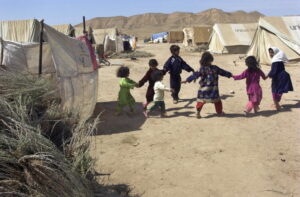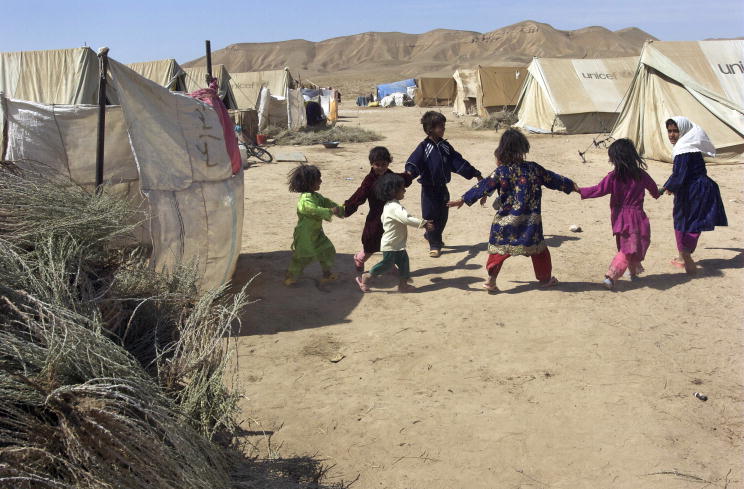By Laura Merriman
Over the twenty-year war in Afghanistan, tens of thousands of Afghan nationals risked their lives to assist the US.[1] In exchange, the US offered them a humanitarian visa known as a Special Immigrant Visa (“SIV”), to safely resettle in the US as lawful permanent residents.[2] However, as the US began withdrawing from Afghanistan, the State Department estimated only 15,000 Afghans had received SIV status.[3] Despite delayed efforts to streamline the process, the US ultimately evacuated thousands of Afghanis before they completed the SIV process.[4] Now the Biden administration is faced with determining how to quickly resettle the 53,200 Afghanis waiting on eight military bases across the US using a resettlement system crippled by the previous administration.[5]
In 2006, Congress authorized fifty annual SIVs for Iraqi and Afghani interpreters.[6] Due to increased threats of kidnapping and violence,[7] Congress expanded the program, first for Iraqis, then for Afghanis with the Afghan Allies Protection Act of 2009 (“AAPA”).[8] The AAPA increased the number of annual SIVs to 1,500 and allowed any Afghan employed by the US for one year, later amended to two years, to apply for SIV status.[9] In addition to faithful service, SIV applicants need evidence of an “ongoing serious threat as a consequence” of their employment.[10] If approved, the individual and their family are admitted to the US as lawful permanent residents and receive the same benefits as refugees including furnished housing, public benefits, and assistance finding jobs.[11]
The SIV application is a fourteen-step process involving at least six different US agencies, and the majority of the process is completed in Afghanistan.[12] The State Department has broken the process into five stages.[13] During stage one, the applicant applies for Chief of Mission approval at the US embassy in Kabul.[14] This stage requires identification documents , verification of employment, letters of recommendation, statement of threat, and a lengthy background check.[15] If approved, the applicant moves to stage two and files a I-360 petition with United States Citizenship and Immigration Services.[16] Once approved, the National Visa Center contacts the applicant to begin stage three, the visa application.[17] The applicant and the family then prepare for stage four, the visa interview.[18] Finally, the applicant reaches stage five, travel to the US.[19]
Despite congressional efforts, the SIV process is plagued with delays.[20] In an attempt to decrease processing time, Congress amended the AAPA to require the State Department to complete review of an SIV application within nine months.[21] However, a lack of staffing and a central database identifying eligible Afghans has led to an average processing time of thirteen months (not counting the time in between stages) with some applications taking over two years.[22] Processing times continued to increase during the Trump administration and were further compounded by COVID-19.[23]
During the final phase of withdrawal from Afghanistan, the Biden administration and Congress tried to further streamline the process as Afghanis faced increased threats from the Taliban.[24] Congress lowered the service requirement to one year, waived certain paperwork, and added 8,000 additional SIVs.[25] In late July, Biden launched “Operation Allies Refuge” to evacuate Afghan SIV applicants to Fort Lee to complete the final steps of the process, starting with 700 SIV applicants and their families (2,500 people in total).[26]
However, these efforts came too late, and the Taliban’s rapid advance in August left mass evacuation as the only option.[27] The US evacuated 124,000 Afghans in its final days, sending thousands to third-party countries to finish their visa applications and 67,000 to eight US military bases across the country.[28] Those lucky enough to qualify for SIVs will be able to complete the process from the bases and, once approved, begin their new life in the US.[29] However, those not eligible for SIVs are in immigration limbo. Having entered the US with humanitarian parole, a temporary legal status, many Afghans have no clear path to a permanent legal status.[30] Absent congressional action, their only option is to apply for asylum and join the 400,000 other asylum seekers waiting for a determination.[31]
As the dust settles, the US must now efficiently resettle 53,200 Afghanis with a resettlement system still recovering from the previous administration’s policies.[32] In fiscal year 2017, the US refugee resettlement program was prepared to resettle 110,000 refugees in one year.[33] However, due to the 85% reduction in refugee admissions during the Trump administration, that infrastructure no longer exists.[34] With lower numbers of arrivals, resettlement agencies cut staff and paused or closed offices to stay afloat.[35] As a result, over one hundred refugee resettlement offices closed between 2016 and 2020.[36]
Today, resettlement agencies are still rebuilding and have limited capacity.[37] The current system requires a local agency office to resettle refugees by finding housing and assisting with benefits and job applications.[38] Many popular locations for Afghan SIVs such as California, Maryland, and Virginia are already at capacity.[39]
In response, the Biden administration has capitalized on public support of Afghan refugees by enlisting private citizens to fill the gaps while resettlement agencies rebuild.[40] The State Department recently authorized a new nonprofit, the Community Sponsorship Hub, to vet and train private citizens to host Afghan families in their community.[41] This new program would allow sponsor circles of five individuals to fill the role traditionally held by the resettlement agencies.[42] The circles must complete background checks, training, raise funds to support the evacuee family for ninety days ($2,275 per refugee), and create a plan for the family.[43]
Overall, resettlement agencies are in favor of his new initiative because it is an opportunity for Americans to directly engage with Afghan families by helping them integrate into the community.[44] Additionally, it increases the number of locations available since SIVs and refugees will not be limited to only cities with resettlement agencies.[45] With the added assistance, agencies are hopeful that they will be able to quickly resettle the Afghan evacuees.[46]
[1] Michelle Hackman, How Do the Highly Sought-After Special Immigrant Visas for Afghans Work?, Wall St. J. (Aug. 23, 2021, 2:08 PM), https://www.wsj.com/articles/how-does-the-14-step-visa-program-for-foreign-interpreters-work-11629414605?mod=article_inline.
[2] Id.
[3] Id.
[4] Molly Hennessy-Fiske, Why Are Most Afghan Evacuees Still Housed at U.S. Military Camps?, L.A. Times, https://www.latimes.com/world-nation/story/2021-10-30/why-have-afghan-refugees-been-held-for-months-on-u-s-bases (Nov. 1, 2021, 2:54 AM).
[5] Id.
[6] National Defense Authorization Act for Fiscal Year 2006, Pub. L. No. 109-163, § 1059(c)(1), 119 Stat. 3136, 3444 (codified at 8 U.S.C. § 1101).
[7] Alissa J. Rubin, U.S. Expands Visa Program for Iraqis, N.Y. Times (July 25, 2008), https://www.nytimes.com/2008/07/25/world/middleeast/25visa.html; Hackman, supra note 1.
[8] Chapter 9 – Certain Afghan Nationals, U.S. Citizenship & Immigr. Servs. (Oct. 29, 2021), https://www.uscis.gov/policy-manual/volume-6-part-h-chapter-9 [hereinafter Certain Afghan Nationals]; see also Daniel F. Runde & Elena Méndez Leal, The Case for Expediting Special Immigrant Visas amid a Transition of Power in Afghanistan, Ctr. for Strategic & Int’l Stud. (Aug. 16, 2021), https://www.csis.org/analysis/case-expediting-special-immigrant-visas-amid-transition-power-afghanistan; Hennessy-Fiske, supra note 4.
[9] Id.; Afghan Allies Protection Act of 2009, Pub. L. No. 111-8, § 602(b)(2)(A)(i)–(ii),123 Stat. 807, 807 (codified at 8 U.S.C. § 1101).
[10] Afghan Allies Protection Act of 2009, § 602(b)(2)(A)(iii)–(iv).
[11] Id. § 602(b)(8)–(9); Hackman, supra note 1.
[12] Runde & Leal, supra note 8.
[13] Id.
[14] Special Immigrant Visas for Afghans – Who Were Employed by/on Behalf of the U.S. Government, Bureau of Consular Affs., U.S. Dep’t of State, https://travel.state.gov/content/travel/en/us-visas/immigrate/special-immg-visa-afghans-employed-us-gov.html#step1 (last visited Nov. 9, 2021) [hereinafter Special Immigrant Visas for Afghans].
[15] Id.; Runde & Leal, supra note 8.
[16] Special Immigrant Visas for Afghans, supra note 14.
[17] Id.
[18] Id.
[19] Id.
[20] Runde & Leal, supra note 8.
[21] Fact Sheet: Overview of the Special Immigrant Visa Programs, Nat’l Immigr. F. (June 22, 2021), https://immigrationforum.org/article/fact-sheet-overview-of-the-special-immigrant-visa-programs/ [hereinafter Fact Sheet].
[22] Review of the Afghan Special Immigrant Visa Program, Office of Inspector Gen., U.S. Dep’t of State, (June, 2020), https://www.stateoig.gov/system/files/aud-mero-20-35-highlights.pdf; Runde & Leal, supra note 8; Fact Sheet, supra note 21.
[23] Hackman, supra note 1.
[24] Id.
[25] Id.; Runde & Leal, supra note 8.
[26] C. Todd Lopez, Fort Lee Chosen as First Stop in U.S. for Relocating Afghans Under Operation Allies Refuge, U.S. Dep’t of Def. (July 19, 2021), https://www.defense.gov/News/News-Stories/Article/Article/2699147/fort-lee-chosen-as-first-stop-in-us-for-relocating-afghans-under-operation-alli/.
[27] Hennessy-Fiske, supra note 4.
[28]Id.; Ben Fox & Ellen Knickmeyer, US Expects to Admit More than 50,000 Evacuated Afghans, AP News (Sept. 3, 2021), https://apnews.com/article/migration-1a704e14f08d0bdf872d84b8e96fd2bf.
[29] Camilo Montoya-Galvez, Afghan Evacuees Face Uncertain Legal Status as They Prepare to Leave U.S. Bases, CBS News (Oct. 7, 2021, 10:10 AM), https://www.cbsnews.com/news/afghanistan-evacuees-legal-status-asylum-us-bases/.
[30] Id.
[31] Id.
[32] Hennessy-Fiske, supra note 4.
[33] Priscilla Alvarez, Resettlement Offices Close as Fewer Refugees Are Allowed into the US, CNN (Sept. 20, 2019, 6:02 AM), https://www.cnn.com/2019/09/20/politics/refugee-resettlement/index.html.
[34] Julie Watson, Broken by Trump, US Refugee Program Aims to Return Stronger, AP News (Jan. 27, 2021), https://apnews.com/article/joe-biden-politics-immigration-coronavirus-pandemic-0a649290b8a6628900598d4324c3d72b.
[35] Id.
[36] Id.
[37] Watson, supra note 34.
[38] Priscilla Alvarez, White House Makes Massive Change to Resettlement Program to Help Afghan Refugees, CNN, https://www.cnn.com/2021/10/23/politics/afghan-refugees-private-resettlement-veterans/index.html (Oct. 23, 2021, 4:13 PM).
[39] Hennessy-Fiske, supra note 4.
[40] Alvarez, supra note 38.
[41] Conor Finnegan, US Launches New Program to Allow Private Americans to Sponsor, Resettle Afghan Refugees, ABC News (Oct. 25, 2021, 1:09 PM ), https://abcnews.go.com/Politics/us-launches-program-private-americans-sponsor-resettle-afghan/story?id=80769922.
[42] Id.
[43] Id.
[44] Id.
[45] Alvarez, supra note 38.
[46] Finnegan, supra note 41.
Post image by United Nations Photo on Flickr


